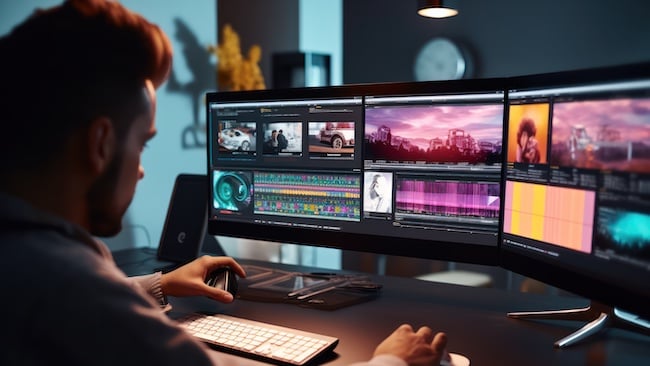3 Ways a Video Producer Can Help You
At its best, producing videos for your business or organization can be fun and creative. It's an outlet that gives your communications or marketing...
7 min read
 Matt Eckholm
:
Nov 21, 2023 9:17:49 AM
Matt Eckholm
:
Nov 21, 2023 9:17:49 AM

Stop me if you’ve heard this one before–online video content continues to grow at an exponential rate. As the flood has increased over the past decade, we’ve begun to reach the point where the average media diet consists more of online video than traditional sources like film and television. And the social media move towards short-form content has only added more fuel to the fire, increasing not just the hours of online content we’re watching, but the sheer volume of videos we’re burning through.
In this environment, anyone starting out creating content for their business or reevaluating their content creation strategy will wonder how it’s possible to create enough video to fuel this insatiable appetite for video. Enter the online video program.
With drag-and-drop templates, stock footage libraries, animated effects, and even AI integration, these programs boast time-saving features and easy-to-use interfaces, aiming to attract both the small businesses with no time or bandwidth for content production and the larger team looking to simplify and templatize certain content needs that are expensive in terms of internal time or external cost.
How can a business evaluate whether online video tools or professional video production is the right direction forward as they plan the next phase of their content calendars? While the variables involved in making that decision are tailored to your own circumstances, taking a look at the online video editing tools available and outlining some of the best and worst use cases can help you decide which direction might best suit your needs.
Promo.com is a tool for creating social media/marketing videos quickly. The most commonly used features are included in the $ 59-a-month plan, which allows unlimited access to stock footage, has animated titles, and more.
Vimeo, known to video professionals as a high-quality video hosting service, now has a video creation suite, aimed at creators who generally create content from their desks. Features include a teleprompter, text-based video editing, and more robust plans including the ability to host webinars and simulcast. Starting at $20 a month.
In addition to the already well-known graphic design features, Canva now sports a drag-and-drop video editor with templates and graphics. Like with the rest of Canva, it’s free to use but most of the best templates/effects are paid.
Veed offers a similar platform to Promo and Canva, but the distinguishing factor is that Veed offers a number of machine-learning features that are useful in the creation of user-generated short-form video content, such as auto-generated subtitles and eye contact correction. The Pro version, which includes these marquee features, is $30 per month.
Another template-based online video editor, Invideo’s main distinguishing features are an AI script editor and automated text-to-speech narration, with subscription plans at $30 and $60 a month.
Like with any creative tool, there are optimal use cases and poor use cases. In the case of some of these online video maker programs, there are several use cases where the programs would be highly effective.
The primary advantage of an easy-to-use, template-based editing software is the ability to generate content without requiring the know-how of traditional programs like Adobe Premiere or Final Cut Pro. Select a template, replace some (or all, or none) of the stock footage, add titles, and you’re done. These tools are aimed primarily at teams without video production capabilities or knowledge.
One thing to keep in mind is that if you subscribe to the paid versions of many of these platforms, you’ll be paying as much or more than you would for an Adobe Creative Suite subscription, with far fewer features. That might be a fine tradeoff if you have no intention of furthering your content creation skills beyond using and editing templates, but if content creation is something you or your team intend to invest time and money into developing as a skill, it’s worth starting with the correct tools.
The ease of using these tools opens up the possibility of generating more videos than a small team could likely produce in-house, or a business could afford to hire a professional video production company. Use cases include creators who need to regularly create new ads, like real estate agents, or businesses interested in running A-B tests on their video ads. If your business depends on rapidly changing situations, like roofing companies following hail storms, you may find templates an easy way to spin up new ads before your competition.
Some of the higher-end packages on these programs allow enterprises to fully control the experience. Veed.io’s enterprise solutions allow robust templates to be created, making the production of near-professional quality videos on an industrial scale possible. However, these tools are only available under custom pricing arrangements, and enterprise solutions come with enterprise price tags.
High-quality video production takes time. While the largest brands are able to take assets from larger media campaigns and commercials and repurpose them into social videos, not everyone has access to that kind of content library. And while some brands and teams flip the phone camera around and make themselves into the content, that doesn’t work for everyone. Online video makers, especially template-based ones, provide a way to create content with less work, preventing social media content production from growing from “one of the many hats” someone wears to a full-time commitment.
While online editing programs can be convenient with templates and flashy features, there are some video needs that aren’t robust enough for online video platforms to solve.
By making the editing tools accessible and easy to use for a majority of end users, there are undoubtedly tradeoffs. It’s possible to do amazing things with simple tools, but the best results from online editing programs are when all the assets going in (user-generated and stock alike) are picture-perfect.
Of course, anyone who has spent time in the video production sphere knows that this is rarely the case. The white balance is off. The handheld video is too shaky. The music you picked out is perfect … except for the middle section, which needs to be edited out on the beat to make a seamless removal. It’s common for any (or all) of these issues to show up on projects, and for teams that make use of professional editing software or work with professional editors, you’d never even know there was an issue.
However, online video editing programs are far less robust, and while they may have some correction tools for common problems if the solution doesn’t work (a noise removal tool that makes your dialogue sound like the speaker is underwater, for example), there’s no further remedy or additional tools to try to solve the issue.
If you’re a sole proprietor or someone bootstrapping content production in addition to several other demanding roles, maybe these issues aren’t a deal breaker for you. However, for those who need to submit their work for approval from multiple stakeholders, or are themselves more exacting on the quality standards of their content creation, these tools can feel restrictive.
That header might sound a bit judgy, but in this context, “quality over quantity” is less about taste than it is about the goals you’ve set for your content.
If your goal is to create lots of paid ads, tailored slightly to different segments of your video ad campaign, you likely aren’t worried about whether the viewer will find your ad to be a work of art. It’s a numbers game, and you’re trying to connect your pitch and relevant information to the right audience, as efficiently as possible. That’s a valid use case for online video makers.
However, if the goal of your campaign is to create an emotional connection with the audience, or to try and engender a feeling or connection to your brand, these tools are a difficult way to accomplish this. Video content that connects takes full advantage of every tool available to an editor–framing, timing, sound, effects, color, among many others–to convey your message. As mentioned above, the editing tools will allow you some leeway in adjusting and tightening your edit, but the lack of precision features will make it difficult to fully control the experience you’re using to convey your message.
Another consideration is your own branding. If you’ve spent time, money, and effort to build a brand guide for your organization, you know how much thought goes into small things, like the way you want your typeface to make your audience feel, the specific pixel ratio of buffer space you want between your logo and other assets, or the sorts of illustrations or stock imagery you associate with your brand. If your brand fonts are unavailable, or the stock illustrations available with your online video editor’s subscription don’t quite match your branding standards, is that a compromise you’re willing to make?
If the goals you have for video production are based on volume, online video makers meet the assignment. If your goals are based on branding, feeling, or messaging, they’re not the best tool for the job.
The elephant in the room when it comes to templates or stock assets is that you’re not the only one who has access to them. And while video editors the world over use the same professional stock photo and video libraries to great creative effect, they aren’t inserting all of that footage into the same sequences. Or using the same graphic treatments on every video.
While the amount of video content on the Internet grows by a staggering volume every day, we only have so many hours in the day we’re willing to spend watching video. Yes, in general, we’re watching more user-generated content than professional content than we have in previous generations, but that’s not an expression of rebellion against mass media. Humans love novelty, and when they get tired of seeing the same thing over and over, they move on in search of the next new thing. This is an inherent problem if you intend to build your video production strategy around templates.
Again, it comes back to the goals you’ve set for video content. If you’re generating content for SEO purposes on a website, like creating videos for each unique SKU on an e-commerce site, online editing programs with templates can be a great help. However, if the goal is to demonstrate how different your product or service is, or break your message through the noisy content landscape of the modern Internet, templates are just about the worst way to accomplish that goal.
There’s no right or wrong way to create a video. There’s no right or wrong tool for creating video. It all comes down to what you hope to accomplish with the end product. And because of that, the unsatisfying answer to the question above is… it depends!
For some, online video makers, editors, and template programs offer just the right amount of support for someone unfamiliar with content creation tools to get their message across. For others, the messaging or content needs are more specialized and require either more robust tools or the bandwidth and skills of a dedicated video production specialist or agency partner.
Before committing in either direction, it’s worth doing a bit of introspective thinking to develop the goals you have for your content, the audience you hope to reach with the content and the time and resources your team has to commit to content creation. With your objectives clearly defined and understood, it’ll be easier to determine how best to create your content, whether that be with online video-making tools or with a professional video production company.

At its best, producing videos for your business or organization can be fun and creative. It's an outlet that gives your communications or marketing...

Lights. Camera. Action! It sounds so easy, but there's much more that goes into a video production—which means there's much more involved than you...

Video works in delivering marketing results. That’s probably why 96% of marketers who have used video say they’ll continue to use it as an ‘important...